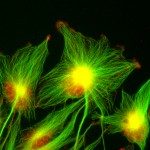Lien vers Pubmed [PMID] – 39097525
Lien vers HAL – pasteur-04777515
Lien DOI – 10.1111/bpa.13294
Brain Pathol 2025 Jan; 35(1): e13294
Glioblastomas are aggressive brain tumors for which effective therapy is still lacking, resulting in dismal survival rates. These tumors display significant phenotypic plasticity, harboring diverse cell populations ranging from tumor core cells to dispersed, highly invasive cells. Neuron navigator 3 (NAV3), a microtubule-associated protein affecting microtubule growth and dynamics, is downregulated in various cancers, including glioblastoma, and has thus been considered a tumor suppressor. In this study, we challenge this designation and unveil distinct expression patterns of NAV3 across different invasion phenotypes. Using glioblastoma cell lines and patient-derived glioma stem-like cell cultures, we disclose an upregulation of NAV3 in invading glioblastoma cells, contrasting with its lower expression in cells residing in tumor spheroid cores. Furthermore, we establish an association between low and high NAV3 expression and the amoeboid and mesenchymal invasive phenotype, respectively, and demonstrate that overexpression of NAV3 directly stimulates glioblastoma invasive behavior in both 2D and 3D environments. Consistently, we observed increased NAV3 expression in cells migrating along blood vessels in mouse xenografts. Overall, our results shed light on the role of NAV3 in glioblastoma invasion, providing insights into this lethal aspect of glioblastoma behavior.

